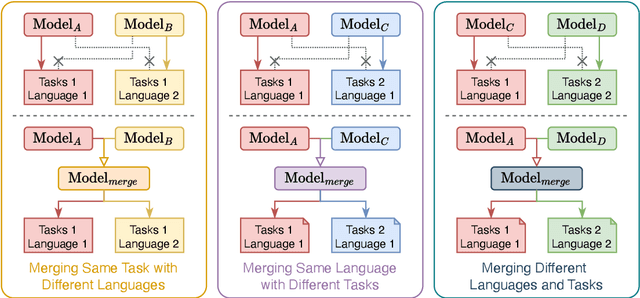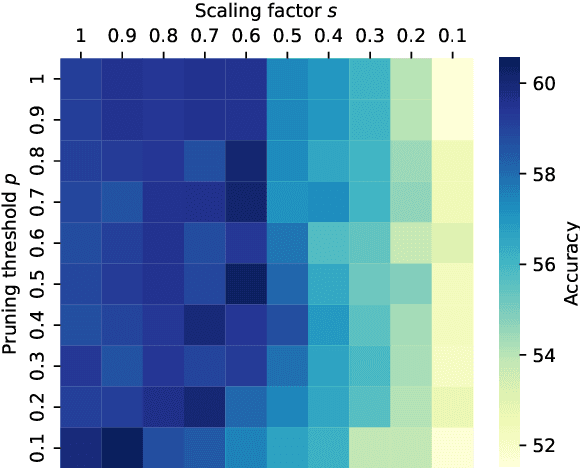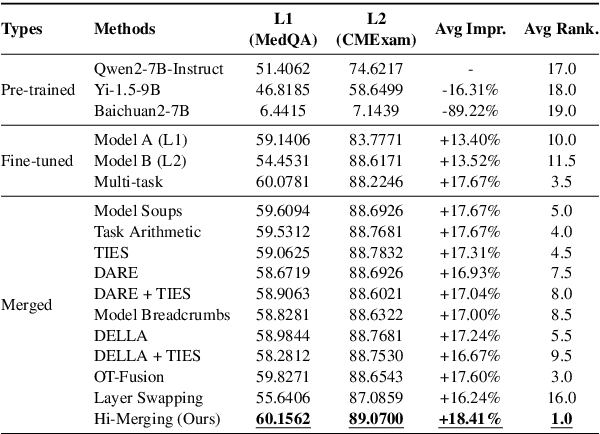Xian Wu
Rethinking the Spatio-Temporal Alignment of End-to-End 3D Perception
Dec 29, 2025Abstract:Spatio-temporal alignment is crucial for temporal modeling of end-to-end (E2E) perception in autonomous driving (AD), providing valuable structural and textural prior information. Existing methods typically rely on the attention mechanism to align objects across frames, simplifying the motion model with a unified explicit physical model (constant velocity, etc.). These approaches prefer semantic features for implicit alignment, challenging the importance of explicit motion modeling in the traditional perception paradigm. However, variations in motion states and object features across categories and frames render this alignment suboptimal. To address this, we propose HAT, a spatio-temporal alignment module that allows each object to adaptively decode the optimal alignment proposal from multiple hypotheses without direct supervision. Specifically, HAT first utilizes multiple explicit motion models to generate spatial anchors and motion-aware feature proposals for historical instances. It then performs multi-hypothesis decoding by incorporating semantic and motion cues embedded in cached object queries, ultimately providing the optimal alignment proposal for the target frame. On nuScenes, HAT consistently improves 3D temporal detectors and trackers across diverse baselines. It achieves state-of-the-art tracking results with 46.0% AMOTA on the test set when paired with the DETR3D detector. In an object-centric E2E AD method, HAT enhances perception accuracy (+1.3% mAP, +3.1% AMOTA) and reduces the collision rate by 32%. When semantics are corrupted (nuScenes-C), the enhancement of motion modeling by HAT enables more robust perception and planning in the E2E AD.
X-ray Insights Unleashed: Pioneering the Enhancement of Multi-Label Long-Tail Data
Dec 24, 2025Abstract:Long-tailed pulmonary anomalies in chest radiography present formidable diagnostic challenges. Despite the recent strides in diffusion-based methods for enhancing the representation of tailed lesions, the paucity of rare lesion exemplars curtails the generative capabilities of these approaches, thereby leaving the diagnostic precision less than optimal. In this paper, we propose a novel data synthesis pipeline designed to augment tail lesions utilizing a copious supply of conventional normal X-rays. Specifically, a sufficient quantity of normal samples is amassed to train a diffusion model capable of generating normal X-ray images. This pre-trained diffusion model is subsequently utilized to inpaint the head lesions present in the diseased X-rays, thereby preserving the tail classes as augmented training data. Additionally, we propose the integration of a Large Language Model Knowledge Guidance (LKG) module alongside a Progressive Incremental Learning (PIL) strategy to stabilize the inpainting fine-tuning process. Comprehensive evaluations conducted on the public lung datasets MIMIC and CheXpert demonstrate that the proposed method sets a new benchmark in performance.
VSA:Visual-Structural Alignment for UI-to-Code
Dec 23, 2025Abstract:The automation of user interface development has the potential to accelerate software delivery by mitigating intensive manual implementation. Despite the advancements in Large Multimodal Models for design-to-code translation, existing methodologies predominantly yield unstructured, flat codebases that lack compatibility with component-oriented libraries such as React or Angular. Such outputs typically exhibit low cohesion and high coupling, complicating long-term maintenance. In this paper, we propose \textbf{VSA (VSA)}, a multi-stage paradigm designed to synthesize organized frontend assets through visual-structural alignment. Our approach first employs a spatial-aware transformer to reconstruct the visual input into a hierarchical tree representation. Moving beyond basic layout extraction, we integrate an algorithmic pattern-matching layer to identify recurring UI motifs and encapsulate them into modular templates. These templates are then processed via a schema-driven synthesis engine, ensuring the Large Language Model generates type-safe, prop-drilled components suitable for production environments. Experimental results indicate that our framework yields a substantial improvement in code modularity and architectural consistency over state-of-the-art benchmarks, effectively bridging the gap between raw pixels and scalable software engineering.
Copy-Paste to Mitigate Large Language Model Hallucinations
Oct 01, 2025Abstract:While Retrieval-Augmented Generation (RAG) enables large language models (LLMs) to generate contextually grounded responses, contextual faithfulness remains challenging as LLMs may not consistently trust provided context, leading to hallucinations that undermine reliability. We observe an inverse correlation between response copying degree and context-unfaithful hallucinations on RAGTruth, suggesting that higher copying degrees reduce hallucinations by fostering genuine contextual belief. We propose CopyPasteLLM, obtained through two-stage high-copying response preference training. We design three prompting methods to enhance copying degree, demonstrating that high-copying responses achieve superior contextual faithfulness and hallucination control. These approaches enable a fully automated pipeline that transforms generated responses into high-copying preference data for training CopyPasteLLM. On FaithEval, ConFiQA and PubMedQA, CopyPasteLLM achieves best performance in both counterfactual and original contexts, remarkably with 12.2% to 24.5% accuracy improvements on FaithEval over the best baseline, while requiring only 365 training samples -- 1/50th of baseline data. To elucidate CopyPasteLLM's effectiveness, we propose the Context-Parameter Copying Capturing algorithm. Interestingly, this reveals that CopyPasteLLM recalibrates reliance on internal parametric knowledge rather than external knowledge during generation. All codes are available at https://github.com/longyongchao/CopyPasteLLM
Building Coding Agents via Entropy-Enhanced Multi-Turn Preference Optimization
Sep 15, 2025Abstract:Software engineering presents complex, multi-step challenges for Large Language Models (LLMs), requiring reasoning over large codebases and coordinated tool use. The difficulty of these tasks is exemplified by benchmarks like SWE-bench, where current LLMs still struggle to resolve real-world issues. A promising approach to enhance performance is test-time scaling (TTS), but its gains are heavily dependent on the diversity of model outputs. While standard alignment methods such as Direct Preference Optimization (DPO) and Kahneman-Tversky Optimization (KTO) are effective at aligning model outputs with human preferences, this process can come at the cost of reduced diversity, limiting the effectiveness of TTS. Additionally, existing preference optimization algorithms are typically designed for single-turn tasks and do not fully address the complexities of multi-turn reasoning and tool integration required for interactive coding agents. To bridge this gap, we introduce \sys, an entropy-enhanced framework that adapts existing preference optimization algorithms to the multi-turn, tool-assisted setting. \sys augments the preference objective to explicitly preserve policy entropy and generalizes learning to optimize over multi-turn interactions rather than single-turn responses. We validate \sys by fine-tuning a diverse suite of models from different families and sizes (up to 106B parameters). To maximize performance gains from TTS, we further propose a hybrid best-trajectory selection scheme combining a learned verifier model with model free approaches. On the \swebench leaderboard, our approach establishes new state-of-the-art results among open-weight models. A 30B parameter model trained with \sys ranks 1st on \lite and 4th on \verified on the open-weight leaderboard, surpassed only by models with over 10x more parameters(\eg$>$350B).
A Multi-Expert Structural-Semantic Hybrid Framework for Unveiling Historical Patterns in Temporal Knowledge Graphs
Jun 17, 2025Abstract:Temporal knowledge graph reasoning aims to predict future events with knowledge of existing facts and plays a key role in various downstream tasks. Previous methods focused on either graph structure learning or semantic reasoning, failing to integrate dual reasoning perspectives to handle different prediction scenarios. Moreover, they lack the capability to capture the inherent differences between historical and non-historical events, which limits their generalization across different temporal contexts. To this end, we propose a Multi-Expert Structural-Semantic Hybrid (MESH) framework that employs three kinds of expert modules to integrate both structural and semantic information, guiding the reasoning process for different events. Extensive experiments on three datasets demonstrate the effectiveness of our approach.
Model Merging for Knowledge Editing
Jun 14, 2025Abstract:Large Language Models (LLMs) require continuous updates to maintain accurate and current knowledge as the world evolves. While existing knowledge editing approaches offer various solutions for knowledge updating, they often struggle with sequential editing scenarios and harm the general capabilities of the model, thereby significantly hampering their practical applicability. This paper proposes a two-stage framework combining robust supervised fine-tuning (R-SFT) with model merging for knowledge editing. Our method first fine-tunes the LLM to internalize new knowledge fully, then merges the fine-tuned model with the original foundation model to preserve newly acquired knowledge and general capabilities. Experimental results demonstrate that our approach significantly outperforms existing methods in sequential editing while better preserving the original performance of the model, all without requiring any architectural changes. Code is available at: https://github.com/Applied-Machine-Learning-Lab/MM4KE.
* 11 pages, 3 figures
Training-free LLM Merging for Multi-task Learning
Jun 14, 2025



Abstract:Large Language Models (LLMs) have demonstrated exceptional capabilities across diverse natural language processing (NLP) tasks. The release of open-source LLMs like LLaMA and Qwen has triggered the development of numerous fine-tuned models tailored for various tasks and languages. In this paper, we explore an important question: is it possible to combine these specialized models to create a unified model with multi-task capabilities. We introduces Hierarchical Iterative Merging (Hi-Merging), a training-free method for unifying different specialized LLMs into a single model. Specifically, Hi-Merging employs model-wise and layer-wise pruning and scaling, guided by contribution analysis, to mitigate parameter conflicts. Extensive experiments on multiple-choice and question-answering tasks in both Chinese and English validate Hi-Merging's ability for multi-task learning. The results demonstrate that Hi-Merging consistently outperforms existing merging techniques and surpasses the performance of models fine-tuned on combined datasets in most scenarios. Code is available at: https://github.com/Applied-Machine-Learning-Lab/Hi-Merging.
* 14 pages, 6 figures
IQE-CLIP: Instance-aware Query Embedding for Zero-/Few-shot Anomaly Detection in Medical Domain
Jun 12, 2025Abstract:Recent advances in vision-language models, such as CLIP, have significantly improved performance in zero- and few-shot anomaly detection (ZFSAD) tasks. However, most existing CLIP-based methods assume prior knowledge of categories and rely on carefully designed prompts tailored to specific scenarios. While these text prompts capture semantic information in the textual space, they often fail to distinguish normal and anomalous instances in the joint embedding space. Moreover, most ZFSAD approaches focus on industrial domains, with limited exploration in medical tasks. To address these limitations, we propose IQE-CLIP, a novel framework for ZFSAD in the medical domain. We show that query embeddings integrating both textual and instance-aware visual information serve as more effective indicators of anomalies. Specifically, we introduce class-based and learnable prompting tokens to better adapt CLIP to the medical setting. Furthermore, we design an instance-aware query module that extracts region-level contextual information from both modalities, enabling the generation of anomaly-sensitive embeddings. Extensive experiments on six medical datasets demonstrate that IQE-CLIP achieves state-of-the-art performance in both zero-shot and few-shot settings. Code and data are available at \href{https://github.com/hongh0/IQE-CLIP/}{this https URL}.
The Butterfly Effect in Pathology: Exploring Security in Pathology Foundation Models
May 30, 2025Abstract:With the widespread adoption of pathology foundation models in both research and clinical decision support systems, exploring their security has become a critical concern. However, despite their growing impact, the vulnerability of these models to adversarial attacks remains largely unexplored. In this work, we present the first systematic investigation into the security of pathology foundation models for whole slide image~(WSI) analysis against adversarial attacks. Specifically, we introduce the principle of \textit{local perturbation with global impact} and propose a label-free attack framework that operates without requiring access to downstream task labels. Under this attack framework, we revise four classical white-box attack methods and redefine the perturbation budget based on the characteristics of WSI. We conduct comprehensive experiments on three representative pathology foundation models across five datasets and six downstream tasks. Despite modifying only 0.1\% of patches per slide with imperceptible noise, our attack leads to downstream accuracy degradation that can reach up to 20\% in the worst cases. Furthermore, we analyze key factors that influence attack success, explore the relationship between patch-level vulnerability and semantic content, and conduct a preliminary investigation into potential defence strategies. These findings lay the groundwork for future research on the adversarial robustness and reliable deployment of pathology foundation models. Our code is publicly available at: https://github.com/Jiashuai-Liu-hmos/Attack-WSI-pathology-foundation-models.
 Add to Chrome
Add to Chrome Add to Firefox
Add to Firefox Add to Edge
Add to Edge